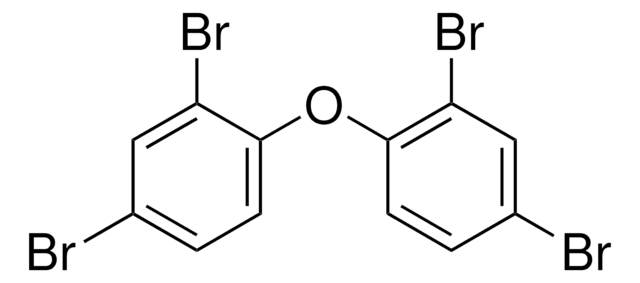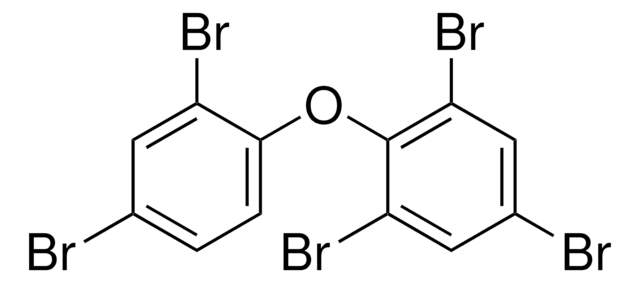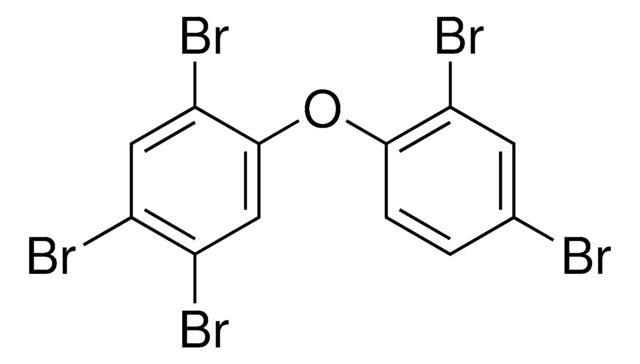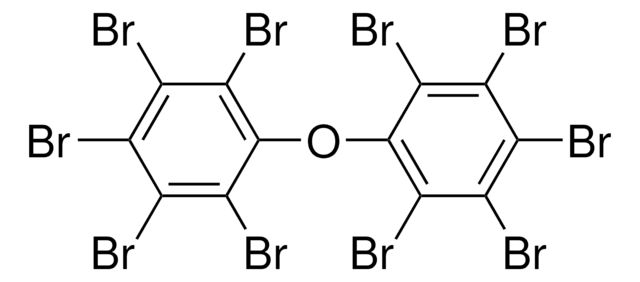33683
BDE No 153 solution
50 μg/mL in isooctane, analytical standard
동의어(들):
2,2′,4,4′,5,5′-Hexabromodiphenyl ether solution, 2,2′,4,4′,5,5′-HexaBDE, PBDE 153
About This Item
추천 제품
Grade
analytical standard
유통기한
limited shelf life, expiry date on the label
농도
50 μg/mL in isooctane
기술
HPLC: suitable
gas chromatography (GC): suitable
응용 분야
environmental
형식
single component solution
저장 온도
2-8°C
SMILES string
Brc1cc(Br)c(Oc2cc(Br)c(Br)cc2Br)cc1Br
InChI
1S/C12H4Br6O/c13-5-1-9(17)11(3-7(5)15)19-12-4-8(16)6(14)2-10(12)18/h1-4H
InChI key
RZXIRSKYBISPGF-UHFFFAOYSA-N
관련 카테고리
일반 설명
애플리케이션
- House dust samples using isotope dilution method combined with liquid chromatography coupled to negative ionization atmospheric pressure photoionization tandem mass spectrometry (LC-NI-APPI-MS/MS).
- Adipose tissue samples using gas chromatography coupled to ion-trap mass spectrometry (GC-IT-MS/MS).
기타 정보
The standard should be transferred to a clean and appropriate vial or flask using clean pipettes or micro pipettes. The vial should be immediately capped to avoid any loss or evaporation of the solvent.
After opening the ampoule, the standard should not be stored or kept in the ampoule. To preserve the integrity of the product, the standard should be transferred to an appropriate vial that must be capped and stored according to the recommendation on the Certificate of Analysis.
신호어
Danger
유해 및 위험 성명서
Hazard Classifications
Aquatic Acute 1 - Aquatic Chronic 1 - Asp. Tox. 1 - Flam. Liq. 2 - Skin Irrit. 2 - STOT SE 3
표적 기관
Central nervous system
Storage Class Code
3 - Flammable liquids
WGK
WGK 2
Flash Point (°F)
10.4 °F
Flash Point (°C)
-12 °C
개인 보호 장비
Eyeshields, Faceshields, Gloves, type ABEK (EN14387) respirator filter
Choose from one of the most recent versions:
이미 열람한 고객
자사의 과학자팀은 생명 과학, 재료 과학, 화학 합성, 크로마토그래피, 분석 및 기타 많은 영역을 포함한 모든 과학 분야에 경험이 있습니다..
고객지원팀으로 연락바랍니다.











